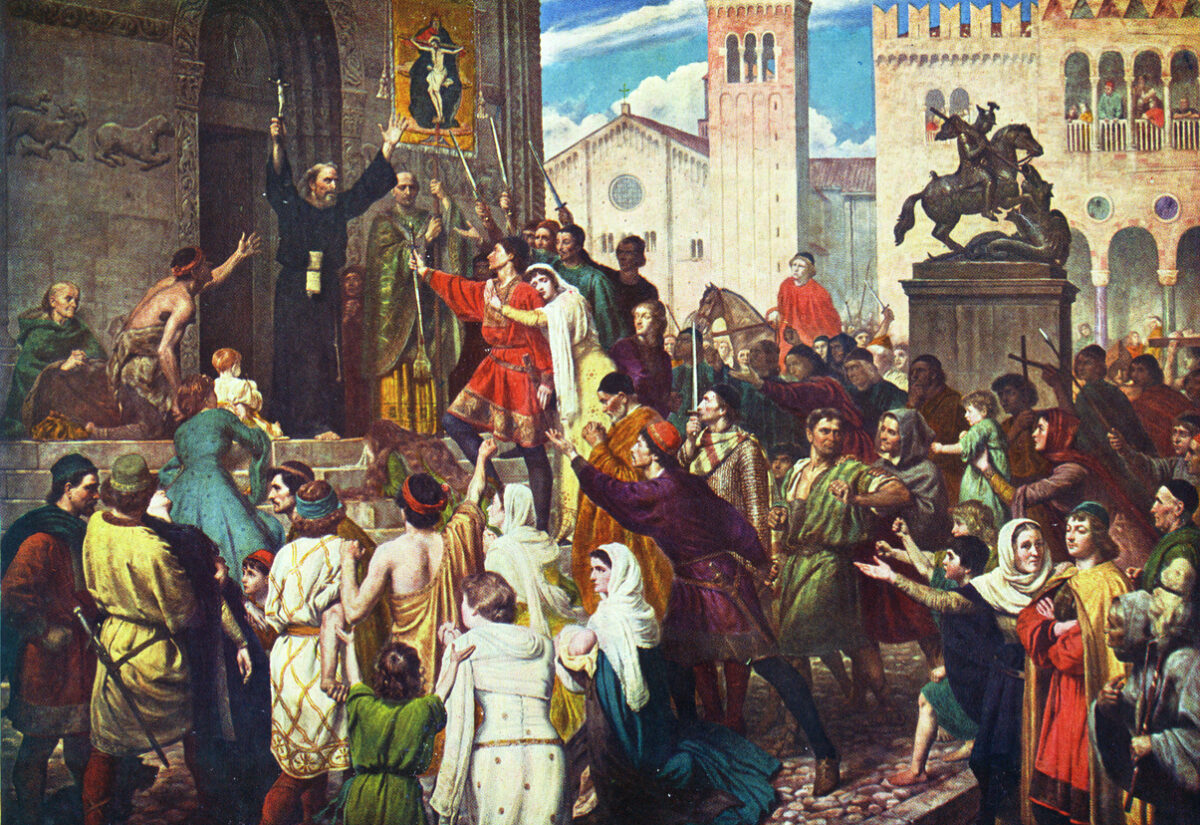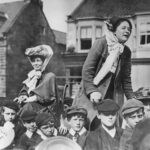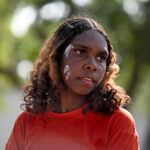Bizarre Medieval Religious Practices The Church Later Banned
- Jennifer Still
- May 17, 2025
 Getty Images
Getty ImagesThe medieval Church is often remembered for its sweeping cathedrals, monastic orders, and solemn liturgies. However, underneath that formal image was a far stranger and more chaotic reality. Throughout Europe, everyday religious life during the Middle Ages was packed with elaborate rituals, theatrical expressions of faith, and peculiar traditions, some of which pushed so far beyond the bounds of doctrine that the Church eventually stepped in to shut them down. These weren’t harmless quirks either. Many were rooted in anxiety, desperation, or superstition. Some were spectacularly dramatic; others were downright gruesome. Here’s a deeper look at the bizarre religious practices that flourished in medieval Europe, until the Church decided enough was enough.
Flagellants whipping themselves in public
In moments of widespread panic, particularly during the Black Death, groups of men known as Flagellants travelled across Europe performing violent public rituals. Believing that the plague was divine punishment for humanity’s sins, they attempted to take that punishment on themselves by marching barefoot through towns and villages, chanting hymns, and brutally whipping their own backs in front of crowds.
These events drew huge audiences. People wept, prayed, and joined in, convinced the Flagellants might help save their communities from disease and damnation. However, the movement quickly turned into a cult-like phenomenon, with some Flagellants denouncing clergy, preaching apocalyptic visions, and rejecting the authority of the Pope. In 1349, Pope Clement VI officially banned the movement, and Church authorities worked to disband the processions. Though the practice briefly re-emerged in later crises, it was never again officially tolerated.
Animal trials
It sounds absurd, but during the Middle Ages, animals were sometimes tried and sentenced in formal court proceedings. From pigs and cows to rats and even insects, animals accused of harming people or crops could be brought before a judge, assigned legal representation, and sentenced to death, or excommunication.
These trials weren’t isolated events. They happened across Europe and were often backed by Church authorities who believed moral order extended to all of God’s creatures. The logic was that animals, as part of creation, could be subject to divine law. The Public Domain Review details some of the most surreal examples, including a 15th-century case where a sow was hanged for infanticide. Eventually, both secular and religious leaders began to see the absurdity of such proceedings, and they were phased out by the early modern period.
The Feast of Fools
Each year, around New Year’s, clergy across parts of France and the Holy Roman Empire threw dignity out the window for the Feast of Fools. This festival featured junior clerics dressing as bishops or popes, parodying sacred rituals, and turning the Mass into a chaotic, farcical spectacle. In some regions, participants even rode donkeys into the sanctuary and brayed instead of singing.
While it may have started as a bit of light-hearted satire or social levelling, it grew increasingly raucous and offensive. Attempts to regulate it failed, and over time the festival attracted heavy criticism from bishops and reformers. By the 15th century, it was banned in most dioceses. Some modern scholars view it as a reflection of medieval society’s need to let off steam, but even the medieval Church had limits.
Selling fake relics
Relics played a central role in medieval Christianity. Pieces of saints’ bodies, splinters of the True Cross, and items supposedly touched by holy figures were displayed in churches, attracting pilgrims and donations. But the market for relics exploded so dramatically that fraud became rampant. Some sellers peddled dozens of heads of John the Baptist, jars of Mary’s milk, or feathers from Gabriel’s wings—all supposedly genuine.
The Church initially struggled to keep up. The Fourth Lateran Council of 1215 introduced rules requiring relics to be verified and approved by local bishops. Despite this, fake relics continued to circulate. Writers like Erasmus and reformers like Martin Luther later mocked the absurdity of the trade. Even today, relic authentication remains a sensitive issue within Catholicism.
Dancing mania
Between the 13th and 17th centuries, groups of people across Europe broke into uncontrollable dancing fits, often lasting for hours or even days. Known as “dancing mania” or “St. Vitus’ Dance,” these events could involve hundreds of participants, some of whom collapsed from exhaustion or even died.
At first, the Church attempted to handle these episodes with spiritual remedies—blessing the dancers, holding special Masses, and organising processions to shrines. But as the outbreaks became more disruptive and sometimes violent, Church leaders began treating them as dangerous hysteria. While causes remain debated, ranging from ergot poisoning to psychological stress, the Church’s response gradually shifted from spiritual interpretation to scepticism and suppression. Research published by the NIH explores the possible neurological explanations behind these events.
Simony and spiritual bribery
The sale of church offices, known as simony, was one of the more deeply entrenched problems of the medieval Church. Wealthy families could buy positions of enormous influence for their relatives, regardless of qualification or morality. Some priests openly paid bribes to become bishops, abbots, or even cardinals.
Despite being condemned by various Church councils, including the Synod of Rome in 1059, simony continued for centuries. The Gregorian Reform movement, led by Pope Gregory VII, took direct aim at this corruption, but progress was uneven. By the time of the Reformation, abuses like simony were among the key criticisms levelled against the Church by reformers like Luther and Calvin.
Holy fasting to extremes
Fasting has always been part of Christian devotion, but some medieval mystics turned it into a full-blown test of sanctity. Female saints in particular, such as Catherine of Siena or Clare of Montefalco, gained reputations for surviving on the Eucharist alone, refusing all other food for long periods.
These extreme fasts were often seen as signs of holiness, and some were even recorded as miracles. However, by the late medieval period, Church officials began to worry. Confessors were instructed to monitor such cases more carefully, and theologians began questioning whether self-starvation was truly divine or dangerously misguided. In some cases, saints were canonised despite their fasting; others were quietly forgotten.
Holy blood theatrics and fake stigmata
Reports of stigmata—miraculous wounds corresponding to those of Christ—fascinated and disturbed the medieval Church in equal measure. St. Francis of Assisi remains the most famous example, but as the phenomenon gained attention, others began making more dramatic and theatrical claims.
There were accounts of blood-soaked garments, statues weeping blood, and even self-inflicted wounds passed off as divine miracles. While some were accepted as genuine and investigated, others were dismissed as fraud. The Church became more cautious, quietly suppressing dubious claims and subjecting new reports to greater scrutiny. A few cases ended in excommunication or imprisonment for fraud.
Mock sermons and preaching animals
In certain parts of Europe, some festivals featured mock sermons delivered by people dressed as animals, or in some cases, by actual animals placed at pulpits in an attempt at absurd humour. The aim was to parody overly complicated theological language or to entertain a crowd with a satirical take on church rituals.
While some of these events began as harmless fun, they eventually drew ire from the Church for undermining the sacredness of the sermon and promoting irreverence. By the 14th century, most dioceses had outlawed these practices, though similar comic performances survived in secular theatre.
Medieval religious life wasn’t all incense and solemnity
It was messy, noisy, and full of eccentricities. Many of the strangest practices weren’t fringe—they were woven into the fabric of religious culture, sometimes celebrated before they were banned. The Church, concerned with both control and reputation, gradually worked to eliminate the more theatrical, unorthodox, or superstitious customs. But their existence reflects a time when spiritual life was inseparable from public spectacle, and when the boundaries between the sacred and the surreal were surprisingly thin.



